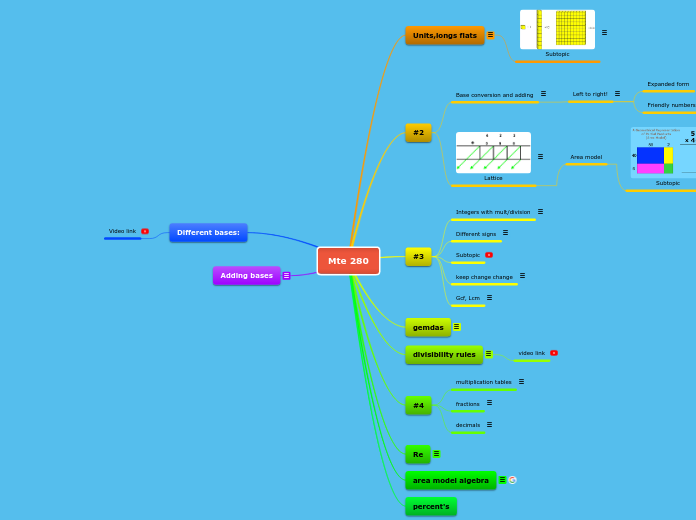Mte 280
Units,longs flats
Units can be represented as a single item.Longs can be thought of as a set group on units to form a long. Flats are bigger then longs they are also a set of longs combined to make a flat. you could say 10 units equals a long as 10 longs will create a flat!

Subtopic
Using these tools can be a great visual for children and adults to help master skills with new bases. It gives you something to physical move and alter while also using the mind. This helps keep us engaged with the process as we take on new bases.
#2
Base conversion and adding
When converting bases we need to always remember what base we are going into and the numbers we can use. You can use multiple methods such as drawing blocks and or use a simple algorithm.
Left to right!
It is as it sounds as we add from left to right. This can look such as 13+5=18. Making sure to keep our place values may be a tricky part as we add accross.
Expanded form
We can use expanded form to show the place values of the number. We can break down numbers and add and such:234=245200+30+4200+40+5 each place value is kept and this can work with large numbers as well.
Friendly numbers
Friendly numbers is a great way to group our numbers so we can gather them in the place value we are comfortable with. for example13+17+11+9In this problem I can see the 13 and 17 would be a great pair to help me get 30 or I could take 7 away from the 17 and add it to the 13 giving me 20. There is plenty of ways to experiment with friendly numbers.
Video link

Lattice
the lattice method gives us a template to place our numbers. This helps when this get messy with addition we can add and then place the values in each box and then add .
Area model

Subtopic
#3
Integers with mult/division
5 (-2) This would be said as 5 groups of two negatives. As apposed to -2 (4) this is said as take away two groups of four positive. 5 -(2) five groups of two negative. Zero banks can be used and often times we have to add positive and negatives to find our answer. If signs are the same answer is positive. If signs are different answer is negative. (-5)(-10)= 50
Different signs
Always check for the signs this will have a major impact in the answer.for example -4+2 -- +We can cancel out one negative with the positive and now we know we can carry the last negative with our answer. 5+(-30++ - Answer would be positive
Subtopic
keep change change
We use keep change change to help us with problems for example. -25-10 We will keeep the -25. Next we will make the problem addition that is the first change. Next we change it from a negative ten to a positive. our problem now looks like -25+10=
Gcf, Lcm
Greatest common factor- Is the greatest factor that divides two numbers. To find the gcf list all the prime factors. multiply those numbers both have in common.Least common multiple:Has two or more of the same quantities. Use a factor tree or downward divison to find factors.Numerator: The top number in a fraction shows how many parts we havedenominator: This is the bottom half of a the fraction and this shows how many make a whole.
gemdas
GemdasGroups: look for plus and minus symbols make groups!expoenets (mutiply, divide) left to right (add subtract) left to right
divisibility rules
2= ends in a even number or last digit divisible by 23= sum of digits divided by three 4= last two digits divisible by four 5= ends in a zero or five 6= if two and three work so does six8= last three divided by 8 9 sum of digits divided by nine 10= ends in zero
video link
#4
multiplication tables
When teaching mutliplication tables we break them in griups based on what should be taught first. We should teach them this way to help students grasp the concepts before moving on to harder problems. These groups can also help with divisibility rules.Group 1: 1,2,5,10 doublesgroup 2: double 3,9griup 3: 4,6,7,8
fractions
When working with fractions you use three boxes for addition. two boxes for subtraction and one box to multiply. We use the boxes to show a diagram when working our problems.
decimals
When working with decimals we needs to know our units,tenths and one hundreths. Also be mindfuln of where our decimal is. When adding we need to cut the box into squares depeding on what place value we are working with. 0.4+0.3 for example we can break our box into ten equal boxes. When working with hundreds we need to cut the box into 100 squares.
Re
Repeated subtraction is a great method for some lower kids. They can pick the number they are comfrotable with and subtract at their own pace. It also sets you up with the answer on the outside and this can be circled as a remineder to where to find the answer.
area model algebra
We can use the area model when dealing with algebra problems. The area model if lined up right will keep x in the same category so when adding is easy. This is another method to solve for x in algebra.
percent's
Different bases:
Video link
Adding bases
Similar to how we add in base ten but we need to be aware what base we are in and the numbers we can use. Once we hit the highest number in the base while adding we need to carry over the appropriate number. Remember to double check that no number is bigger the that base allows ! This would be a good time to use the blocks to help guide along with the grouping !
